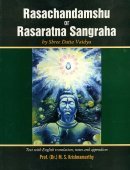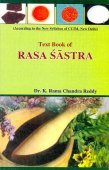Gomeda, Go-meda: 13 definitions
Introduction:
Gomeda means something in Hinduism, Sanskrit, Jainism, Prakrit, biology. If you want to know the exact meaning, history, etymology or English translation of this term then check out the descriptions on this page. Add your comment or reference to a book if you want to contribute to this summary article.
In Hinduism
Ayurveda (science of life)
Rasashastra (Alchemy and Herbo-Mineral preparations)
Source: Wisdom Library: Rasa-śāstraGomeda (गोमेद, “Hessonite”):—One of the nine gems (navaratna) according to the 13th century Rasaprakāśasudhākara. When its colour is similar to gomedas (cow’s fat) or similar to very clear cow’s urine, it is considered as śuddha or of superior quality.
The Hessonite (gomeda) has Pharmaco-therapeutic properties and possesses the following characteristics:
- It pacifys pitta-doṣa,
- destroys kapha-doṣa, pāṇḍuroga and kṣaya-roga,
- stimulates digestive fire,
- acts as a good digestive (appatizer),
- produces relishness (rūci)
- and promotes intelligence to great extent
Superior: When the Hessonite is possessed of the following characteristics, it is considered superior: Bright shining, greasy appearance, free from dalas (layers/scales), smooth on touch, having the shade similar to clear cow’s urine, clear inlook, sama (uneven) on surface. When containing these characteristics, the Gomeda is considered garīya (of best quality) and may be used for all purposes.
Inferior: The Hessonite is considered inferior when it exhibits the following traits: Does not contain proper shade, flat, without shining, having dry surface, small in size, containing scales/layers, light in weight and similar to pīta-kāca (yellow glass).
Source: History of Science in South Asia: Making Gems in Indian Alchemical LiteratureGomeda (गोमेद) refers to “garnets” or “zircons” for which alchemical formulas are provided in order to create these gems, according to the Vādakhaṇḍa section of the Rasaratnākara (lit. “jewel mine of mercury”): a 13th century alchemical work in Sanskrit written by Nityanātha.—Verses 1-40 of chapter 19 continues with a series of formulations for creating gems. These formulations stand on their own and do not seem to be integrated into a larger alchemical programme of making mercurial elixirs. The gems to be created include [garnets or zircons (gomeda)], [...] None of the recipes for producing these gems are found in any other Sanskrit alchemical work.

Āyurveda (आयुर्वेद, ayurveda) is a branch of Indian science dealing with medicine, herbalism, taxology, anatomy, surgery, alchemy and related topics. Traditional practice of Āyurveda in ancient India dates back to at least the first millenium BC. Literature is commonly written in Sanskrit using various poetic metres.
Purana and Itihasa (epic history)
Source: Cologne Digital Sanskrit Dictionaries: The Purana Index1a) Gomeda (गोमेद).—Mt. one of the seven hills of Plakṣadvīpa; gives its name to Gomedavarṣa.*
- * Brahmāṇḍa-purāṇa II. 19. 7, 138; Matsya-purāṇa 123. 28; Vāyu-purāṇa 49. 6; Viṣṇu-purāṇa II. 4. 7.
1b) Another name for the country Śāntabhayam in the Plakṣadvīpa;1 surrounding the sea of wine and surrounded by sugar-cane juice sea;2 encircles the Kumuda hill.3

The Purana (पुराण, purāṇas) refers to Sanskrit literature preserving ancient India’s vast cultural history, including historical legends, religious ceremonies, various arts and sciences. The eighteen mahapuranas total over 400,000 shlokas (metrical couplets) and date to at least several centuries BCE.
Shaivism (Shaiva philosophy)
Source: Wisdom Library: ŚaivismGomeda (गोमेद) refers to one of the seven continents (saptadvīpa) situated within the world of the earth (pṛthivī), according to Parākhyatantra 5.61. It is also known as Gomedadvīpa. These continents are located above the seven pātālas and may contain even more sub-continents within them, are round in shape, and are encircled within seven concentric oceans.
According to the Parākhya-tantra, “beyond that is the continent Gomedas, where, because of the curse of Gautama, a hundred cows were killed, and there then flowed fat: becauseof the profusion of that fat the continent got its name. Outside that is the ocean of liquor which reeks of the perfume of the blood of gods, intoxicated by which Vidyādharas and Gandharvas revel”.
The Parākhyatantra is an old Śaiva-siddhānta tantra dating from before the 10th century.

Shaiva (शैव, śaiva) or Shaivism (śaivism) represents a tradition of Hinduism worshiping Shiva as the supreme being. Closely related to Shaktism, Shaiva literature includes a range of scriptures, including Tantras, while the root of this tradition may be traced back to the ancient Vedas.
In Jainism
General definition (in Jainism)
Source: archive.org: The Jaina IconographyGomeda (गोमेद) or Gomedha is the name of the Yakṣa accompanying Neminātha: the twenty-second of twenty-four Tīrthaṃkaras or Jinas, commonly depicted in Jaina iconography.—Neminātha’s emblem is known to be a conch-shell from the Jaina canonical texts. The Śāsana-devatās who attend upon him are Yakṣa Gomedha and Yakṣiṇī Ambikā (Digambara: and Kuṣmāṇḍinī). The Chowri-bearer, in his case, is King Ugrasena. His Kevala-tree is called Mahāveṇu or Vetasa.

Jainism is an Indian religion of Dharma whose doctrine revolves around harmlessness (ahimsa) towards every living being. The two major branches (Digambara and Svetambara) of Jainism stimulate self-control (or, shramana, ‘self-reliance’) and spiritual development through a path of peace for the soul to progess to the ultimate goal.
Biology (plants and animals)
Source: Google Books: CRC World Dictionary (Regional names)Gomeda in India is the name of a plant defined with Cinnamomum tamala in various botanical sources. This page contains potential references in Ayurveda, modern medicine, and other folk traditions or local practices It has the synonym Laurus tamala Buch.-Ham. (among others).
Example references for further research on medicinal uses or toxicity (see latin names for full list):
· Transactions of the Linnean Society of London (1822)
· Botanica expeditior (1760)
· FBI (1886)
· Handbuch der medicinisch-pharmaceutischen Botanik (1831)
· Species Plantarum (1753)
If you are looking for specific details regarding Gomeda, for example chemical composition, pregnancy safety, health benefits, extract dosage, side effects, diet and recipes, have a look at these references.

This sections includes definitions from the five kingdoms of living things: Animals, Plants, Fungi, Protists and Monera. It will include both the official binomial nomenclature (scientific names usually in Latin) as well as regional spellings and variants.
Languages of India and abroad
Sanskrit dictionary
Source: DDSA: The practical Sanskrit-English dictionaryGomeda (गोमेद).—a gem brought from the Himālaya and Indus, described as of four different colours:-white, pale-yellow, red, and dark-blue.
Derivable forms: gomedaḥ (गोमेदः).
Gomeda is a Sanskrit compound consisting of the terms go and meda (मेद).
Source: Cologne Digital Sanskrit Dictionaries: Shabda-Sagara Sanskrit-English DictionaryGomeda (गोमेद).—m.
(-daḥ) A yellow gem: see the next.
Source: Cologne Digital Sanskrit Dictionaries: Monier-Williams Sanskrit-English Dictionary1) Gomeda (गोमेद):—[=go-meda] [from go] m. ‘cow-fat’, a gem brought from the Himālaya and the Indus (being of 4 sorts, white, pale yellow, red, and dark blue), [Religious Thought and Life in India] p.468
2) [v.s. ...] the tree kakkola, [cf. Lexicographers, esp. such as amarasiṃha, halāyudha, hemacandra, etc.]
3) [v.s. ...] a kind of fish, [Demetrius Galanos’s Lexiko: sanskritikes, anglikes, hellenikes]
4) [v.s. ...] Name of a mountain, [Viṣṇu-purāṇa ii, 4, 7]
5) [v.s. ...] of a Dvīpa, [Romakasiddhānta; Matsya-purāṇa cxxii]
Source: Cologne Digital Sanskrit Dictionaries: Yates Sanskrit-English DictionaryGomeda (गोमेद):—[go-meda] (daḥ) 1. m. A yellow gem.
Source: DDSA: Paia-sadda-mahannavo; a comprehensive Prakrit Hindi dictionary (S)Gomeda (गोमेद) in the Sanskrit language is related to the Prakrit words: Gomea, Gomejja.
[Sanskrit to German]
Sanskrit, also spelled संस्कृतम् (saṃskṛtam), is an ancient language of India commonly seen as the grandmother of the Indo-European language family (even English!). Closely allied with Prakrit and Pali, Sanskrit is more exhaustive in both grammar and terms and has the most extensive collection of literature in the world, greatly surpassing its sister-languages Greek and Latin.
See also (Relevant definitions)
Starts with: Gomedadvipa, Gomedagandhika, Gomedaka, Gomedapratikasha, Gomedasamnibha, Gomedasannibha, Gomedavarsha.
Full-text (+11): Pitaratnaka, Gomedasannibha, Gomedasamnibha, Navaratna, Trinacara, Ushanahpriya, Pingasphatika, Rahuratna, Gomedaka, Gomedadvipa, Gomedavarsha, Uttamamani, Gangola, Gomed, Gomejja, Gomea, Ratna, Gururatna, Navratna, Dvipa.
Relevant text
Search found 24 books and stories containing Gomeda, Go-meda; (plurals include: Gomedas, medas). You can also click to the full overview containing English textual excerpts. Below are direct links for the most relevant articles:
Rasa Jala Nidhi, vol 3: Metals, Gems and other substances (by Bhudeb Mookerjee)
Part 1 - Characteristics of Zercon (gomeda) < [Chapter XVIII - Gems (6): Gomeda (zercon)]
Samarangana-sutradhara (Summary) (by D. N. Shukla)
Puranic encyclopaedia (by Vettam Mani)
Historical Elements in the Matsya Purana (by Chaitali Kadia)
Saptadvīpa (6): Gomedakadvīpa < [Chapter 4 - Geographical history in the Matsya-Purāṇa]
The Agni Purana (by N. Gangadharan)
The Garuda Purana (by Manmatha Nath Dutt)
Related products

